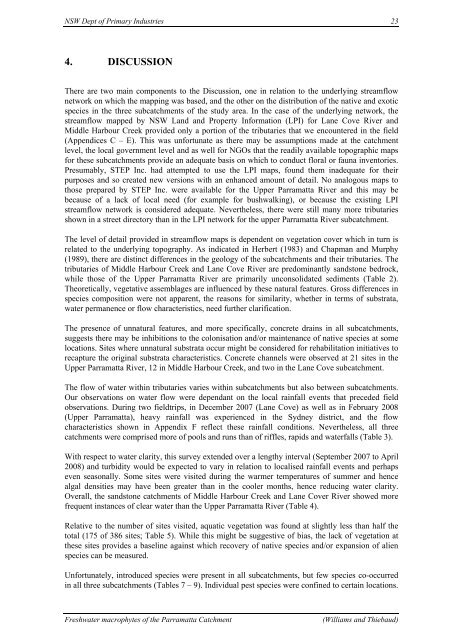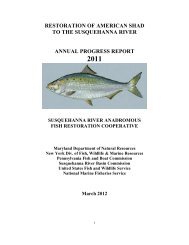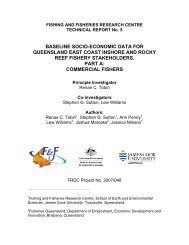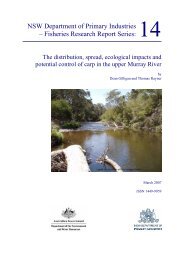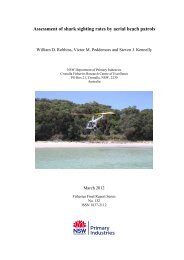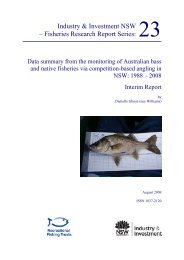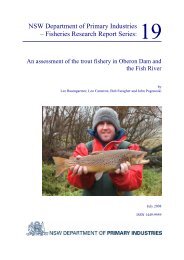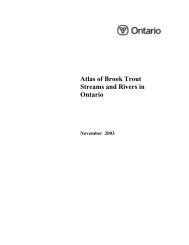The freshwater macrophytes of - Fisheries Reports
The freshwater macrophytes of - Fisheries Reports
The freshwater macrophytes of - Fisheries Reports
Create successful ePaper yourself
Turn your PDF publications into a flip-book with our unique Google optimized e-Paper software.
NSW Dept <strong>of</strong> Primary Industries 23<br />
4. DISCUSSION<br />
<strong>The</strong>re are two main components to the Discussion, one in relation to the underlying streamflow<br />
network on which the mapping was based, and the other on the distribution <strong>of</strong> the native and exotic<br />
species in the three subcatchments <strong>of</strong> the study area. In the case <strong>of</strong> the underlying network, the<br />
streamflow mapped by NSW Land and Property Information (LPI) for Lane Cove River and<br />
Middle Harbour Creek provided only a portion <strong>of</strong> the tributaries that we encountered in the field<br />
(Appendices C – E). This was unfortunate as there may be assumptions made at the catchment<br />
level, the local government level and as well for NGOs that the readily available topographic maps<br />
for these subcatchments provide an adequate basis on which to conduct floral or fauna inventories.<br />
Presumably, STEP Inc. had attempted to use the LPI maps, found them inadequate for their<br />
purposes and so created new versions with an enhanced amount <strong>of</strong> detail. No analogous maps to<br />
those prepared by STEP Inc. were available for the Upper Parramatta River and this may be<br />
because <strong>of</strong> a lack <strong>of</strong> local need (for example for bushwalking), or because the existing LPI<br />
streamflow network is considered adequate. Nevertheless, there were still many more tributaries<br />
shown in a street directory than in the LPI network for the upper Parramatta River subcatchment.<br />
<strong>The</strong> level <strong>of</strong> detail provided in streamflow maps is dependent on vegetation cover which in turn is<br />
related to the underlying topography. As indicated in Herbert (1983) and Chapman and Murphy<br />
(1989), there are distinct differences in the geology <strong>of</strong> the subcatchments and their tributaries. <strong>The</strong><br />
tributaries <strong>of</strong> Middle Harbour Creek and Lane Cove River are predominantly sandstone bedrock,<br />
while those <strong>of</strong> the Upper Parramatta River are primarily unconsolidated sediments (Table 2).<br />
<strong>The</strong>oretically, vegetative assemblages are influenced by these natural features. Gross differences in<br />
species composition were not apparent, the reasons for similarity, whether in terms <strong>of</strong> substrata,<br />
water permanence or flow characteristics, need further clarification.<br />
<strong>The</strong> presence <strong>of</strong> unnatural features, and more specifically, concrete drains in all subcatchments,<br />
suggests there may be inhibitions to the colonisation and/or maintenance <strong>of</strong> native species at some<br />
locations. Sites where unnatural substrata occur might be considered for rehabilitation initiatives to<br />
recapture the original substrata characteristics. Concrete channels were observed at 21 sites in the<br />
Upper Parramatta River, 12 in Middle Harbour Creek, and two in the Lane Cove subcatchment.<br />
<strong>The</strong> flow <strong>of</strong> water within tributaries varies within subcatchments but also between subcatchments.<br />
Our observations on water flow were dependant on the local rainfall events that preceded field<br />
observations. During two fieldtrips, in December 2007 (Lane Cove) as well as in February 2008<br />
(Upper Parramatta), heavy rainfall was experienced in the Sydney district, and the flow<br />
characteristics shown in Appendix F reflect these rainfall conditions. Nevertheless, all three<br />
catchments were comprised more <strong>of</strong> pools and runs than <strong>of</strong> riffles, rapids and waterfalls (Table 3).<br />
With respect to water clarity, this survey extended over a lengthy interval (September 2007 to April<br />
2008) and turbidity would be expected to vary in relation to localised rainfall events and perhaps<br />
even seasonally. Some sites were visited during the warmer temperatures <strong>of</strong> summer and hence<br />
algal densities may have been greater than in the cooler months, hence reducing water clarity.<br />
Overall, the sandstone catchments <strong>of</strong> Middle Harbour Creek and Lane Cover River showed more<br />
frequent instances <strong>of</strong> clear water than the Upper Parramatta River (Table 4).<br />
Relative to the number <strong>of</strong> sites visited, aquatic vegetation was found at slightly less than half the<br />
total (175 <strong>of</strong> 386 sites; Table 5). While this might be suggestive <strong>of</strong> bias, the lack <strong>of</strong> vegetation at<br />
these sites provides a baseline against which recovery <strong>of</strong> native species and/or expansion <strong>of</strong> alien<br />
species can be measured.<br />
Unfortunately, introduced species were present in all subcatchments, but few species co-occurred<br />
in all three subcatchments (Tables 7 – 9). Individual pest species were confined to certain locations.<br />
Freshwater <strong>macrophytes</strong> <strong>of</strong> the Parramatta Catchment (Williams and Thiebaud)


